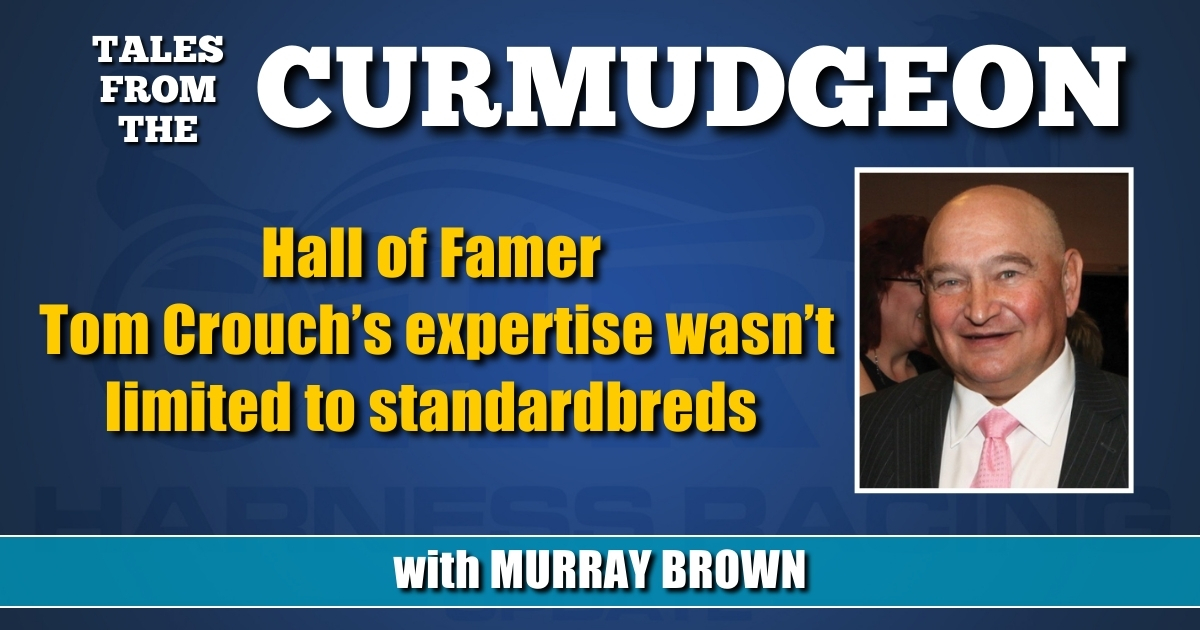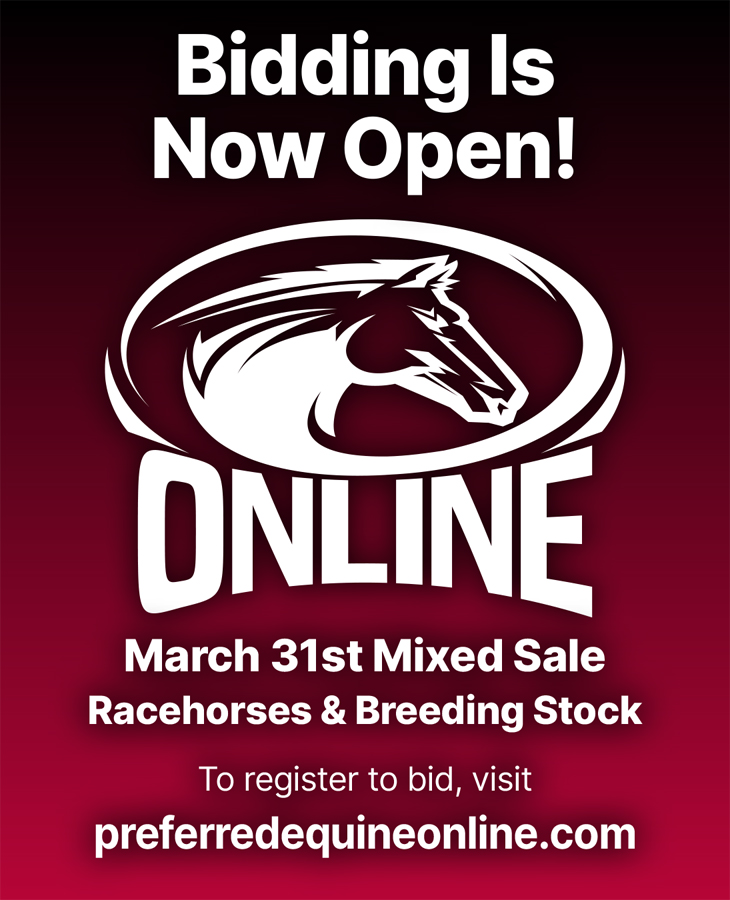Hall of Famer Tom Crouch’s expertise wasn’t limited to standardbreds
A conversation with the founder of Kentuckiana Farms and the Kentucky Standardbred Horse Sale.
by Murray Brown
Tom Crouch was raised on a dairy farm in small town Indiana where, he said, “We were poor, but never hungry.”
For as long as he can remember, he considered himself to be a livestock man, mostly relating to hogs, but also including cattle, chickens and horses.
“Above just about everything else one needs to have an eye for quality and a sense of value,” Crouch said. “I always had a great eye for hogs, but speaking in generalities, if you know what you’re looking at in one species of farm animal, it will generally extend to most.”
At the age of 20, he was offered a chance to move to Chicago where he became a livestock analyst and a hog buyer for one of the largest companies where he was responsible for purchasing upwards of 135,000 hogs a year.
Young Crouch’s reputation for quality buying and livestock breeding reached across the Atlantic to England where he was asked to consult with the leading hog breeders in the United Kingdom. That journey resulted in upwards of 60 per cent of the hog population in North America tracing to those hogs that Crouch was responsible for bringing to these shores in 1975.
By this time, the reader is probably wondering, since this is a periodical relating to harness racing, what do hogs have to do with it?
Actually, Crouch views hog breeding as his major means to becoming involved in his passion for harness racing.
“It was something that I think I was good at,” he said. “It allowed me to earn enough to become involved in harness racing, initially as an owner and then as a breeder. I had a great passion for breeding quality, especially quality racehorses. Without passion in this life of ours you are doomed to mediocrity at best and the likelihood of failure.”
How did your life in harness racing evolve?
“It goes back to my roots in rural Indiana. We’d go to all of the state fairs where we showed and sold our livestock. Almost all the fairs had harness racing. I watched it and became hooked. My wife Betty and I bought our first horse, Boutoniere, back in 1967. We raced her at the fairs. She won her last start at the Indiana State Fair in Indianapolis and we sold her to Normand Dauplaise at a good profit. I thought to myself, ‘This is an easy business.’ Little did I know.
“When we moved to Chicago, there were numerous people on the Mercantile Exchange who owned horses among them were Brian Monieson, Lloyd Arnold, Don Stevens, Craig Mahlstedt, Steve Newcom and George Segal. I’ve known a lot of wonderful people in my journey through life. Brian Monieson was one of the very best. He possessed just about all of the positive attributes that a man could have. He was brilliant, kind and was a whiz with numbers. He began as a tout sheet operator at Sportsman’s Park. We became habitues of the Chicago tracks. I met Gene Riegle and Jim Dennis, two of the greatest horsemen I have been privileged to have known.
“The first top horse I was associated with was Try Scotch. I, together with Steve Newcom and Craig Mahlstedt, bought him from Jerry Snyder who was looking to cash him in to buy a new house. He was with Mike Zeller and doing very well. Mike had a deathly fear of flying and told me that Try Scotch was too good to stay where we were racing. He said that he wouldn’t fly and we wouldn’t do the horse justice by staying where he was. He suggested that we give him to Jim Dennis to train and drive.
“Jim, the great gentleman that he was, wouldn’t take the horse unless it was cleared with Mike. Mike called Jim and told him that it was okay with him and wished him the best of luck with him. Try Scotch went on and won 47 races and $956,770. With all the hundreds of horses I’ve been associated with I’ve never enjoyed one more than Try Scotch. Of course, we had many other pretty good ones after him.”
Among your claims to fame is that you together with Bill Shehan started the Kentucky Standardbred Horse Sale. How did that evolve?
“Bill and I were selling our consignments at Tattersalls. I’m not about to say that all was rosy while we were there, but I will say that we were not terribly unhappy until we were blindsided by the powers that owned the sale. We were promised spots in the sale and then without any consultation, they were taken away from us. Not only that, but our commission was structured at a rate where we were paying almost double the going rate in commission to be treated as second class citizens. Bill called me and said that we should start our own sales company. I agreed and we held our first sale in 1978 selling around 120 high-quality yearlings. It went great and we were flooded with interest and entries for the next year’s sale. Soon after, Armstrong Brothers came in both as a major consignor and part owner of the sales company. Dr. Glen Brown represented Armstrong on our board. I’ve never had a better partner than Dr. Brown proved to be.
“The powers that be at Tattersalls were upset. They were losing consignors. Fred Van Lennep said that he would tell consignors and buyers that if they did business with us, they wouldn’t get stalls at Pompano Park. Our attorney responded, that if he did that, we would soon own Pompano Park and Castleton Farm. We didn’t hear anything further.”
What are some of the most monumental achievements or thrills in your life in harness racing?
“In terms of racing, the greatest would probably have been when Naughty But Nice won the Jugette driven by Tommy Haughton. In breeding, among a host of thrills would have been, together with Betty, building one of the great broodmare bands in harness racing. In terms of specifics, standing and managing the stud career of Yankee Glide one of the world’s foremost trotting stallions. Another would be in breeding Horse of the Year Staying Together, of which I owned and bred both his sire and his dam.”
You’ve known many outstanding people in your long career in the sport. Tell us about a few.
“There have been so many. Gene Riegle, Carter Duer, Bill Haughton, George Sholty, Glen Garnsey, Jim Dennis, Delvin Miller and so many more. Of those, Gene was among the very best to ever look at and evaluate a yearling. He didn’t need to look at one for long either. Another one that could really pick a yearling was Dr. Peter Boyce. Carter Duer has to be one of the greatest horsemen that ever lived. When he first left Castleton Farms, he came to work for me and helped me establish Kentuckiana Farms. The fact that he is not in the Hall of Fame does nothing, but in my opinion, cast shame on that institution.”
What keeps you occupied these days?
“I still do some day-to-day trading, but only for my own account. I need to keep my mind occupied. I’m not in the best of health, but fortunately I’m still upright. I’ve had five back surgeries and two on my hips. We live year-round here in New Smyrna Beach, FL. I try to get to Spring Garden Ranch and the Pinske Training Center to watch the youngsters in training as often as this old body allows me to. I still have a strong interest in the sport and its people. That won’t go until I do.”
Is there anything else that you would care to speak of?
“We, and by we, I mean my wife Betty and me; Betty is an excellent horse person in her own right. We built Kentuckiana Farms broodmare band into one of the greatest in all of harness racing. Bill Shehan had hit a bump in the road financially. He had opened a nightclub in Lexington that really strapped him for cash. He was over extended and had to sell his broodmares and his farm. We and George Segal bought the mares and George bought the farm. Those mares are the genesis of many of the great broodmares that were the foundation of the great broodmare bands at both Kentuckiana and Brittany Farms.”

















